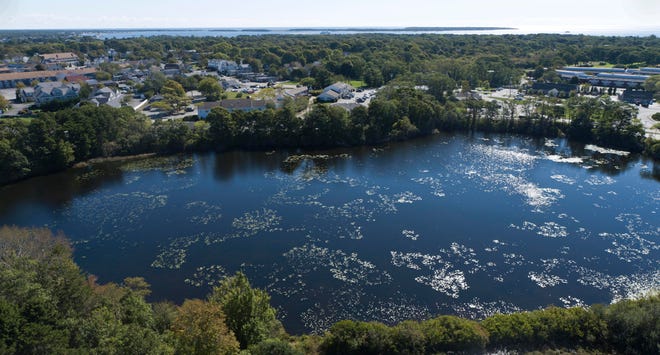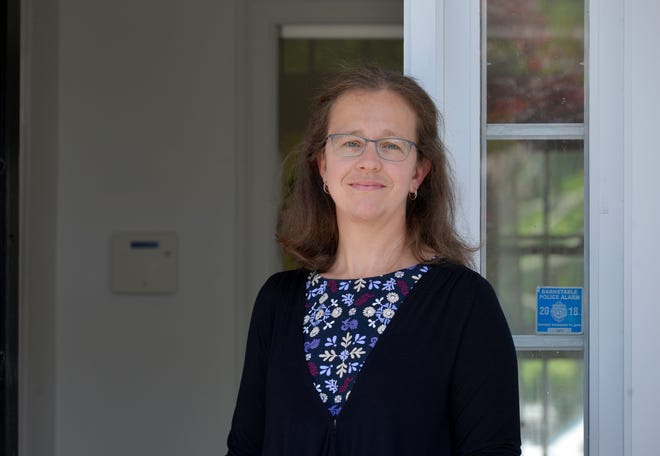PFAS contamination: Of 21 Barnstable ponds tested, 21 had contaminants, town report finds
In July 2020, Tom Cambareri dragged his kayak to the shore of Aunt Bettys Pond in Barnstable. He paddled out to the middle and dropped his sampling equipment into the water.
Cambareri, a hydrologist and the founder of Sole Source Consulting, was on a mission for the town of Barnstable. His goal was to better map the landscape of PFAS contamination in the town’s surface water bodies as the search for new sources of drinking water to meet rising demand intensifies.
The issue:As Barnstable hunts for new sources of public drinking water, PFAS contamination rears its ugly head
Cambareri ultimately collected water samples from 21 water bodies in town, according to a report he produced in December 2020.

The results from lab tests of those samples showed PFAS compounds were present in every water body tested, with some registering PFAS levels far above the state standard for drinking water. There is no standard for PFAS contamination insurface water bodies, such as ponds and creeks.
PFAS, or per- and polyfluoroalkyl substances, are a group of thousands of manmade chemicals linked to health problems ranging from immune system issues to cancer. The chemicals remain essentially unregulated at the federal level, but some states, including Massachusetts, have begun to put safe drinking water limits on a few of the more well-researched compounds.
State DEP:PFAS chemical contamination at Hyannis airport not investigated enough
In 2020, Massachusetts instituted a drinking water standard of 20 nanograms per liter for a group of six PFAS compounds, which are now known as the PFAS6.
Of the 21 samples Cambareri collected, seven had PFAS6 levels that exceeded the state drinking water standard. The sample taken at Aunt Bettys Pond had one of the highest readings: 141.4 nanograms per liter, roughly seven times the state drinking water standard.
Cambareri tested for 18 other PFAS compounds that haven’t yet been regulated by the state or federal government.
Keating:Air Force agrees to pay for PFAS cleanups in Mashpee and Falmouth wells
Three water bodies had total PFAS levels exceeding 200 nanograms per liter, three had levels exceeding 100 nanograms per liter, and five had levels exceeding 20 nanograms per liter.
At Aunt Bettys Pond, total PFAS levels registered at 237.9 nanograms per liter, the second-highest reading after its feeder system, Hyannis Creek, where levels topped 252 nanograms per liter
When Cambareri compared PFAS levels in the surface water bodies he sampled to PFAS levels in Hyannis’s public drinking wells before treatment, he confirmed that contamination in ponds, lakes and creeks was correlated with contamination in village wells.
“… Areas with high concentrations of PFAS contamination in surface water bodies also have similarly high concentrations of contamination in wells,” Cambareri wrote.
“Because of this relationship we can assume that development of wells in an area with high concentrations of PFAS in surface water would result in high concentrations of PFAS in wells, thus resulting in higher treatment costs,” he added.
Laurel Schaider, a senior scientist at Silent Spring Institute, where she leads the institute’s water quality research on PFAS, reviewed Cambareri’s report at the Times’ request.

“I think this is a really important report,” Schaider said Friday. “It’s a reminder of the interconnectedness of groundwater and surface water on the Cape. Given what we know about the high levels of PFAS reaching the drinking water wells in Hyannis, it’s not surprising that the ponds in those same areas have similar levels of PFAS.”
Cambareri said in his report that, as the town considers new sources of drinking water, it should rule out places where PFAS contamination is known to be present in nearby surface water bodies.
Help needed: Cape towns look to Congress to help pay PFAS cleanup costs
“By taking account of the behavior of contamination plumes from multiple sources, several future well sites can be ruled out,” Cambareri wrote in his report. “For example, two of the most convenient potential future well sites located within Hyannis, thus requiring the shortest transmission mains, have a high degree of risk because of the presence of multiple PFAS sources.”
Where is the contamination coming from?
The Barnstable County Fire Rescue and Training Academy and the Cape Cod Gateway Airport — two locations where PFAS-laden firefighting foam was applied for decades — are two known sources of significant PFAS contamination in Hyannis.
The levels of PFAS detected at those sites are staggering. At the fire training academy, tests done after some cleanup efforts showed total PFAS concentrations in groundwater there reached 167,510 nanograms per liter. At the airport, total PFAS concentrations in groundwater have reached 15,583 nanograms per liter, according to Cambareri’s report.
The Hyannis Water District began removing PFAS from public drinking water wells contaminated by those sites in 2015 and has since brought the level of PFAS contamination in the public drinking water supply down to non-detect levels.
Elsewhere: 'Forever chemicals' detected in Chatham drinking water wells
But Cambareri’s report found that PFAS emanating from the fire training academy and airport was redistributed across the village through contaminated well water before that treatment began.
PFAS, which were designed to be water, stain and fire-resistant, are often called “forever chemicals” because they do not break down naturally in the environment. Rather, they accumulate, in soil, in water, in animals, and in people. Beyond firefighting foam, PFAS can be found in packaging, cooking pans, cosmetics and other consumer products.
Highly persistent PFAS from the fire training academy and airport distributed through Hyannis before drinking water treatment began are combining with highly persistent PFAS from consumer products that end up in wastewater from homes and businesses, Cambareri found.
PFAS from wastewater ends up in the groundwater in two ways.
If a property is connected to a sewer , its wastewater is sent to the Barnstable Water Pollution Control facility, where it is treated — though not for PFAS — before being discharged into local groundwater.
If a property is not connected to the town's sewage treatment plant and relies on a septic system, its wastewater is leached into the groundwater on-site without being treated for PFAS. When the septic tank is pumped, the wastewater goes to the Barnstable Water Pollution Control Facility, where it is discharged into groundwater without being treated for PFAS.
All of this PFAS, from the fire training academy, the airport, the treatment plant or individual septic tanks, ends up in Hyannis’s groundwater, where it circulates throughout the village.
“The redistribution of primary PFAS sources in Hyannis resulted in widespread secondary groundwater contamination in the Hyannis area aquifer,” Cambareri wrote.
Schaider said Cambareri’s report is a reminder that local governments need to follow through on ongoing efforts to clean up sites that are highly contaminated with PFAS, including the fire training academy and airport.
“The Hyannis water system has gone to great lengths to treat the drinking water supply for the town, but as these results show, there are still elevated levels of PFAS in the groundwater and in the surface water in this whole area,” she said. “So it's important to, as much as we can, remediate the sources so that no new PFAS are getting out into the environment and for us to continue to monitor the levels in water and in fish over time.”
'A hodepodge':'A hodgepodge': Draft PFAS assessment plan for Barnstable fire academy plume is inadequate
What is the town doing in response to the report?
Barnstable Director of Public Works Daniel Santos denied the Times’ request to speak with Cambareri, the former water resources program manager for the Cape Cod Commission, about the report’s findings.

The Barnstable Health Department referred questions to Santos, and Town Manager Mark Ells did not return a call to his office requesting an interview about the report.
Santos said the biggest takeaway from Cambareri’s report is “that there is PFAS in surface waters and groundwaters throughout the town of Barnstable.”
That information will guide the town’s search for new sources of drinking water, as Cambareri’s report found surface water contamination correlates with groundwater contamination.

No comments:
Post a Comment